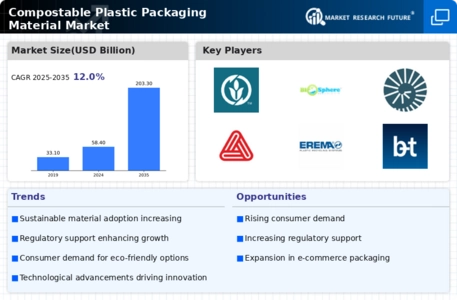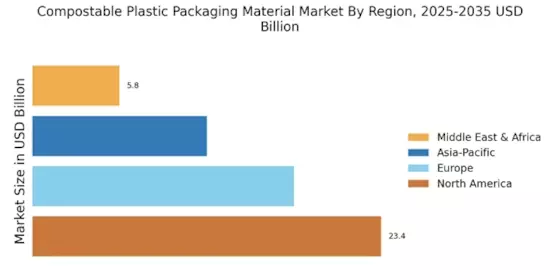Rising Environmental Awareness
The increasing awareness regarding environmental issues appears to be a pivotal driver for the Compostable Plastic Packaging Material Market. Consumers are becoming more conscious of their ecological footprint, leading to a surge in demand for sustainable packaging solutions. This shift in consumer behavior is reflected in market data, indicating that the compostable packaging segment is projected to grow at a compound annual growth rate of approximately 15% over the next five years. As individuals and organizations alike prioritize eco-friendly practices, the Compostable Plastic Packaging Material Market is likely to experience significant growth, driven by the desire to reduce plastic waste and promote a circular economy.
Consumer Preference for Convenience
The growing consumer preference for convenience is emerging as a significant driver for the Compostable Plastic Packaging Material Market. As lifestyles become increasingly fast-paced, consumers are seeking packaging solutions that offer ease of use while being environmentally friendly. Compostable packaging provides a convenient option for consumers who wish to minimize their environmental impact without sacrificing functionality. Market data shows that products packaged in compostable materials are gaining traction, with a reported increase in sales of 25% in the last year alone. This trend indicates that the demand for convenient yet sustainable packaging solutions is likely to propel the growth of the Compostable Plastic Packaging Material Market.
Government Regulations and Policies
Regulatory frameworks and policies aimed at reducing plastic waste are increasingly influencing the Compostable Plastic Packaging Material Market. Governments across various regions are implementing stringent regulations to limit the use of conventional plastics, thereby encouraging the adoption of compostable alternatives. For instance, several countries have introduced bans on single-use plastics, which has catalyzed the demand for compostable packaging solutions. Market data suggests that regions with robust regulatory support are witnessing a faster adoption of compostable materials, potentially leading to a market expansion of over 20% in the next few years. This regulatory push is likely to create a favorable environment for the Compostable Plastic Packaging Material Market.
Corporate Sustainability Initiatives
Many corporations are increasingly integrating sustainability into their business models, which is likely to bolster the Compostable Plastic Packaging Material Market. Companies are recognizing the importance of sustainable practices not only for compliance but also for enhancing brand reputation and customer loyalty. As a result, there is a growing trend of businesses opting for compostable packaging solutions to align with their sustainability goals. Market data indicates that companies adopting eco-friendly packaging are experiencing a 30% increase in customer engagement. This trend suggests that the commitment to sustainability among corporations could significantly drive the growth of the Compostable Plastic Packaging Material Market.
Technological Innovations in Production
Technological advancements in the production of compostable materials are playing a crucial role in shaping the Compostable Plastic Packaging Material Market. Innovations in biopolymer technology and manufacturing processes are enhancing the performance and cost-effectiveness of compostable packaging solutions. These advancements are making it feasible for manufacturers to produce high-quality compostable materials at competitive prices, thereby increasing their market penetration. Recent data indicates that the cost of producing compostable plastics has decreased by approximately 10% due to these technological improvements. This trend suggests that as production becomes more efficient, the Compostable Plastic Packaging Material Market may witness accelerated growth and wider adoption.


















Leave a Comment